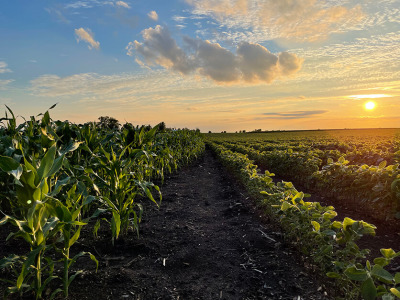Editor's note: This preview of farm bill issues will be updated periodically with new proposals.
The House and Senate Agriculture Committees are still several months away from voting on a new farm bill, but the major issues in each of the 12 titles are coming into focus even as lawmakers continue offering new proposals they’d like to see included.
The bill is setting up to be more evolutionary than revolutionary, reflecting in part farm groups’ satisfaction with the structure of the 2018 farm bill, as well as the tight budget environment and divided Congress.
Plus, the 2022 Inflation Reduction Act pumped $17 billion into farm bill conservation programs with additional funding for clean energy and forestry programs that were priorities for President Joe Biden’s climate policy.
The 2018 farm bill was “very effective” ‘and tried and tested under some difficult circumstances,” including the trade war with China and COVID-19 pandemic,” House Agriculture Committee Chairman Glenn “GT” Thompson, R-Pa., said in an Agri-Pulse Open Mic interview.
“All of it’s going to get critical analysis to make sure that we don't miss an opportunity for refinement. But … what's the old adage? If it's not broken, don't fix it,” Thompson said.
Still, Thompson and the top Republican on the Senate Agriculture Committee, John Boozman of Arkansas, have pledged to provide for or some kind of increase in Price Loss Coverage reference prices. There also are an array of issue that while relatively small in the grand scheme of the $1.5 trillion bill are important to key sectors, including producers of fruits, vegetables and other specialty crops who are looking to the farm bill in part to expand their crop insurance options and also help accelerate automation.
 Ferd Hoefner, farm policy consultant
Ferd Hoefner, farm policy consultantAdvocates of major farm bill reform "likely believe that this is not the right farm bill to move very far to achieve their ends," said Ferd Hoefner, a farm policy consultant and former policy director for the National Sustainable Agriculture Coalition.
But Hoefner sees the potential for a fight with long-term implications over bringing IRA funding into the farm bill in order to ensure that it can be used to permanently increase funding levels for conservation programs. "The ability to turn short term IRA funding into long term farm bill funding could yield an additional $60-plus billion dollars in future farm bill baseline looking out over the horizon of the next five or so farm bills toward agriculture's net zero goal by 2050," he said.
Here is a description of each of the 12 titles as well as a summary of the major issues in play and a listing of notable measures, known as marker bills, that lawmakers have introduced for possible inclusion in the farm bill.
| Title XI: Crop Insurance | |||
Title I: Commodity
What it does: Authorizes income-support programs — including the Agriculture Risk Coverage and Price Loss Coverage programs for grains, oilseeds, cotton and pulse crops — and the Dairy Margin Coverage program for milk producers. Disaster assistance programs for livestock producers and the Noninsured Crop Disaster Assistance Program (NAP) also are included in the title, as well as the Tree Assistance Program to help orchards and nurseries replant and rehabilitate damaged trees, bushes and vines.
What it costs: $69 billion, or 5%, of the projected 10-year cost of farm bill programs through 2033, according to the latest Congressional Budget Office forecast as analyzed by the Congressional Research Service.
What’s in play: Under pressure from commodity groups, the Republican leaders of the House and Senate Agriculture Committees have pledged to provide some increase in PLC reference prices. Under PLC, payments to farmers are triggered when the average market price for the year falls below the reference price. Commodity groups argue the reference prices don’t reflect recent increases in market prices, despite an escalator provision that allowed the reference prices to rise by as much as 15% when the five-year average of market prices increases. The challenge for lawmakers is not only to find the money to address reference prices but to raise them in a way that doesn’t pit commodities and regions against one another.
Some House Ag Committee members also would like to allow an update of PLC and ARC base acreage that would allow farmers without base to get into the programs. PLC and ARC payments are tied to historical cropping patterns rather than actual plantings.
Interested in the Farm Bill with Current updates? It’s easy to sign up for a FREE month of Agri-Pulse news! For the latest on what’s happening in Washington, D.C. and around the country in agriculture, just click here.
Payment eligibility rules will almost certainly be an issue on the House and Senate floor when amendments are debated. Leading the charge again in the Senate will be Iowa Republican Chuck Grassley, who has long called for tightening the definition of being “actively engaged” in farming, a requirement for receiving payments. There also are proposals to modify the $900,000 limit on adjusted gross income for eligible producers.

The National Milk Producers Federation says dairy producers should be allowed to update the production histories used for DMC coverage.
There had been some discussion about creating a permanent disaster assistance program but that has died down. There are several proposals in play to liberalize rules for the disaster assistance programs, including NAP and the Tree Assistance Program.
House Republicans also have eyed USDA's Commodity Credit Corp. account as a potential source of funding for the farm bill. Reinstating restrictions on USDA's use of the CCC that were in place before the Donald Trump administration would save an estimated $1 billion a year, according to the Congressional Budget Office. The restrictions face stiff Democratic opposition, however.
A handful of House progressive are proposing a sweeping overhaul of farm programs, the Food and Farm Act, which would eliminate the two primary income-support programs for row crops, Agriculture Risk Coverage and Price Loss Coverage, and increase conservation compliance requirements, which apply to crop insurance and conservation assistance as well as commodity programs. As of early July, The bill introduced by Rep. Earl Blumenauer, D-Ore., has just five co-sponsors, all Democrats.
Notable marker bills:
S.2097 — Bipartisan proposal led by Sen. John Hoeven, R-N.D., to adjust rules for the Livestock Forage Disaster Program (LFP) and the Emergency Assistance for Livestock, Honeybees, and Farm-Raised Fish (ELAP).
S.2035 — Proposal by Sen. Mike Rounds, R-S.D., to expand coverage under the Noninsured Crop Disaster Assistance Program for crops and grasses used for grazing.
H.R.1020 — The BAITS Act, sponsored by Rep. Barry Moore, R-Ala., would expand the Livestock Indemnity Program (LIP) to producers of farm-raised fish.
H.R.1824 — The Food and Farm Act, led by Rep. Earl Blumenauer, D-Ore., would impose sweeping new limits on commodity subsidies and tighten eligibility rules, cutting the AGI limit from $900,000 to $400,000.






